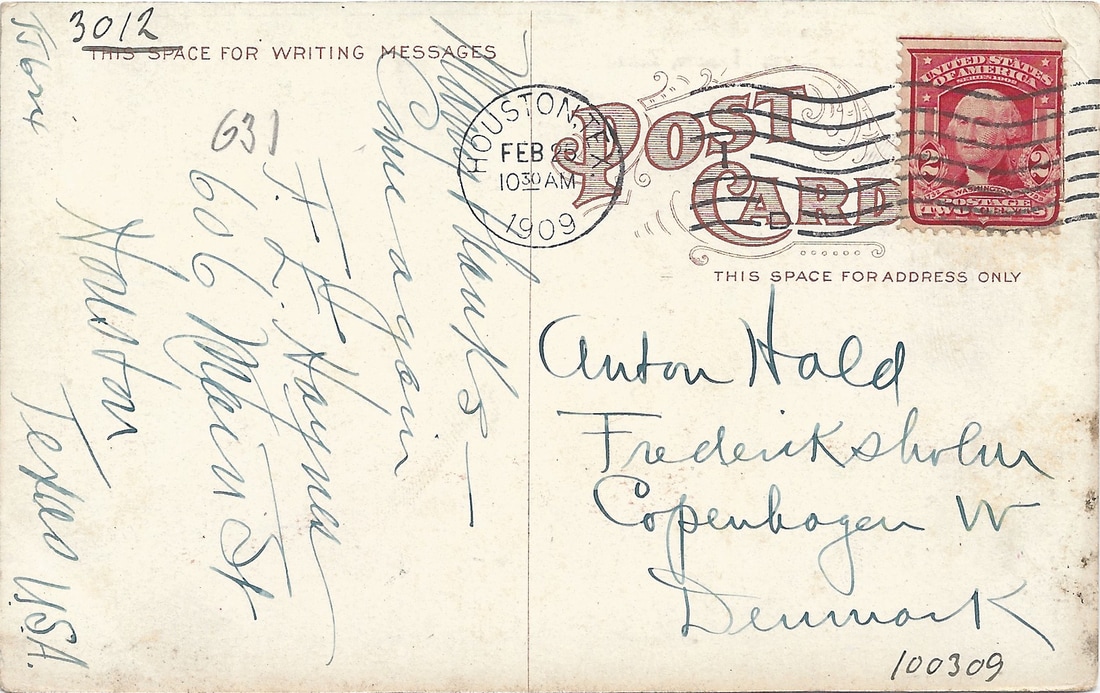Taub House
|
25 February 1909: The mansion on the corner belonged to the Taub Family. They were proprietors of J. N. Taub and Sons, a cigar store at 418 Main. Jacob Nathan Taub immigrated from Hungary in 1882 and became a tobacco wholesaler with retail outlets in several downtown lobbies, fathering Max (1873-1945), Sam (1876-1956), Otto (1879-1925), Risa Margaret (1883-1963), and Olga Taub Raphael (1889-1962) and Ben Taub (1889–1982), a medical philanthropist who was one of the early drivers of the Texas Medical Center and the University of Houston. Ben Taub General Hospital, in the Medical Center was named in his honor.
The multistory structure farther down is The Savoy Apartments built in 1906, the tallest building in Houston at that time (see The Savoy). The Methodist Church so prominent in later views was not built until 1910, so is lacking in this 1909 view. At this early date the congregation still gathered at Shearn Methodist Church in the 800 block of Texas between Milam and Travis. |
19 June 2015: With two entrances, 1300. Main and 900 Polk, the 21 story Travis Tower office building dominates the north half of the block. When it was built in 1955, it was topped with a rotating triangle, the logo of Conoco, the major tenant, which changed color to reflect weather conditions. The Methodist Church, which anchors the south half of the block, seems strangely out of place.
|
|
To: Anton Hald
Frederiksholm, Copenhagen W Denmark Postmarked: Houston, Tex. Feb 26, 1909 Stamp: 2c Carmine George Washington #319 {International postage rate for the "Penny Postcard" was 2 cents} Message: Many Thanks ~ Come again F. E. Haynes 606 Main St Houston Texas USA JJ624 |
At the time he wrote this postcard, Frederick Ellsworth Haynes was the manager of the Kress store at 606 - 608 Main. The 600 block between Texas and Capitol was one of the busiest in Houston {See Main at Texas ~ South}. Kress neighbors were Shotwell clothes, the Pantitorium, Philip Battlestein, tailor, Tamme Delicatessen,, Singer Sewing Machines, Vlahos Fruit Stand, various barbers, dentists, realtors, and pharmacists. Despite the fact that the Haynes family lived at 805 Gray, Fred gave his business address for returns, perhaps because he spent so much time at work he preferred his mail to come to the store.
This Kress store was not the historic one remaining into the present at 705 Main. That much larger store was not built until 1913, constructed according to the Art Deco decorative style of the time with abundant terra cotta ornamentation. Kress stores were found on Main Streets all across America, and Samuel Henry Kress built them to be visual landmarks that contributed to the urban cityscape and attracted customers to spend idle time and scarce dollars there. Fred was a highly active postcard collector, and a member of at least nine postcard collecting clubs. These organizations maintained membership lists of collectors and their interests, and guaranteed that their members were on the up-and-up. Haynes marks himself as “JJ624,” a membership number that would have signaled authenticity. This was, it must be remembered, an era when proper social introductions were very important. Other club members soliciting exchanges would often direct their correspondence to “Dear J.J.” to mark their membership. The clubs were often international in membership, and since Haynes urges his correspondent to “come again,“perhaps had personally met Anton Hald, his Danish Correspondent. Anton was from Copenhagen, Denmark, husband of Regine Augusta Buesten, but little else has been learned about him. Frederick Haynes didn’t stay long in Houston, managing other Kress stores in Roanake (1917; 1920), and Hackensack, NJ (1930). He died in Bergen County, NJ in 1959 at the age of 79 and is buried in Brookside Cemetery in Englewood. |
|
In complement to the above scene from Polk toward the south, a different view from Clay Street toward the north shows the church from the opposite direction (shown here with an inset from Polk Street, as shown above). Postcards from the era were manufactured as lithographs, often specified as hand-colored, which indicated that the half-tone key black image was finished out with hand cut stencils in various colors, which could differ from one printing to another.
In the view from Clay Street, the house just past the Methodist Church is depicted in yellow. Another view of the Church from a third angle shows the front entrance from Main Street. In this third view, the house is depicted in red. Whatever color this house was painted or depicted in postcard images, it was a boarding house run by Elizabeth Kirby [See Methodist Church -Front Entrance]. |


